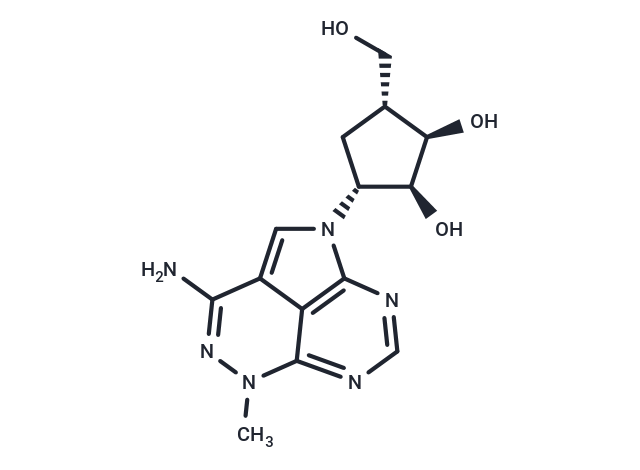Shopping Cart
- Remove All
 Your shopping cart is currently empty
Your shopping cart is currently empty

Triciribine (NSC-154020) is a DNA synthesis inhibitor, and it also inhibits Akt and HIV-1/2.

| Pack Size | Price | Availability | Quantity |
|---|---|---|---|
| 1 mg | $36 | In Stock | |
| 2 mg | $52 | In Stock | |
| 5 mg | $85 | In Stock | |
| 10 mg | $137 | In Stock | |
| 25 mg | $249 | In Stock | |
| 50 mg | $415 | In Stock | |
| 100 mg | $619 | In Stock | |
| 1 mL x 10 mM (in DMSO) | $94 | In Stock |
| Description | Triciribine (NSC-154020) is a DNA synthesis inhibitor, and it also inhibits Akt and HIV-1/2. |
| Targets&IC50 | Akt:130 nM, HIV-1:20 nM |
| In vitro | Triciribine exhibits maximum growth inhibition around 1-10 μM and inhibits phosphorylation of Akt, as well as downstream p70S6K, to basal levels at 100 μM (IC50 = 130 nM). Triciribine shows particular promise for inhibiting growth in Nf1 and Trp53 mutant astrocytoma cells in a grade-dependent manner. The WHO II K1861-10 line is inhibited, incompletely (69% maximum inhibition), with a GI50 value of 1.7 μM for Triciribine, whereas higher-grade tumor lines (KR158, KR130, and SF295) are inhibited to a greater extent (>80% maximum inhibition) at lower GI50 values (0.4–1.1 mM). Importantly, Triciribine is much less effective at inhibiting primary astrocytes (GI5013.6 mM), suggesting that this inhibitor may show specificity for tumor cells. [1] Triciribine inihibits HIV-1with an IC50 of 20 nM. Greater than 90% inhibition is achieved at 0.1 μM and complete inhibition of syncytia formation is achieved at 5 μM. Associated cell toxicity in the same cell line for Triciribine is 46 μM, resulting in selectivity indices of 2250. Triciribine markedly inhibits HIV-1-induced p24 core antigen production, reverse transcriptase, and infectious virus production in a dose-dependent manner using HIV-1 acutedly infected CEM-SS, H9, and persistently infected H9III B and U1 cells. [2] Triciribine inhibits Akt phosphorylation at Thr308 and Ser473 and Akt activity in the human prostate cancer cell line PC-3. Triciribine sensitizes PC-3 cells to TRAIL- and anti-CD95-induced apoptosis, whereas the cells remain resistant to DNA damaging chemotherapeutics. [3] Triciribine is highly selective for Akt and does not inhibit the activation of phosphatidylinositol 3-kinase, phosphoinositide-dependent kinase-1, protein kinase C, serum and glucocorticoid-inducible kinase, protein kinase A, signal transducer and activators of transcription 3, extracellular signal-regulated kinase-1/2, or c-Jun NH2-terminal kinase. [4] |
| In vivo | 1 mg/kg/day i.p. treated Triciribine inhibits OVCAR3, OVCAR8 and PANC1 tumor growth, which overexpressing Akt, by 90%, 88% and 80% in nude mice, respectively. However, Triciribine has little effect on the growth of OVCAR5 and COLO357 cells. [4] |
| Kinase Assay | Akt Phosphorylation Changes Assay: Cells are grown to 80%–90% confluency and stimulated for 5–10 minutes with 1–10 ng/mL of epidermal growth factor or platelet derived growth factor (PDGF)–AA with or without 10–20 mM of U0126 or LY-294002. Protein lysates (5–20 μg) are separated by 12%–15% SDS PAGE and analyzed by Western blot for Akt, phosphorylated Akt (phospho-Ser 473), MAPK, and phosphorylated MAPK (p44/42 phospho-Thr202/Tyr204) antibodies (1:1000). |
| Cell Research | Triciribine is evaluated for cytotoxicity by seeding CEM-SS cells at a density of 1 × 104 cells/well in growth medium, using a 96-well flat-bottom plate. Serial fivefold dilutions of Triciribine are prepared in growth medium and added to the wells as a second overlay. After a 48-hours incubation at 37 °C, the cells are pulse labeled with [3H]dThd (1 μCi per well, specific activity 20 Ci/mmol) for 6 hours and the cells are harvested to measure total DNA synthesis.(Only for Reference) |
| Alias | VD-0002, Tricyclic nucleoside, TCN, NSC 154020, API-2 |
| Molecular Weight | 320.3 |
| Formula | C13H16N6O4 |
| Cas No. | 35943-35-2 |
| Smiles | Cn1nc(N)c2cn([C@@H]3C[C@H](CO)[C@@H](O)[C@H]3O)c3ncnc1c23 |
| Relative Density. | 1.2633 g/cm3 (Estimated) |
| Storage | Powder: -20°C for 3 years | In solvent: -80°C for 1 year | Shipping with blue ice. | ||||||||||||||||||||||||||||||
| Solubility Information | DMSO: 32 mg/mL (99.91 mM), Sonication is recommended. | ||||||||||||||||||||||||||||||
Solution Preparation Table | |||||||||||||||||||||||||||||||
DMSO
| |||||||||||||||||||||||||||||||

Copyright © 2015-2025 TargetMol Chemicals Inc. All Rights Reserved.